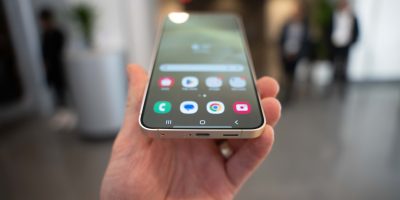
We’ve already seen inside the GSM Samsung Galaxy Nexus, but how does its LTE companion compare? There is definitely some shifting of components on the motherboard, but claims that the handset currently exclusive to Verizon utilizes a different chipset are simply bogus. Earlier today, ZDNet posted a teardown of the newly released handset identifying a certain piece of hardware as the phone’s “1.2GHZ Samsung Exynos 4210 processor (CMC221 NAA969.00A-1 B1139 ARM).” In actuality, the LTE Galaxy Nexus retains the same 1.2GHz Texas Instruments OMAP 4460 dual-core chip found in the GSM variant.
The CMC221 a Samsung-made LTE chip and is coupled with a Via Telecom CBP7.1 1x/EVDO chip, the same baseband combination found in the LTE-enabled Samsung Droid Charge. So sorry, folks, Sammy didn’t slip an Exynos chip in under the radar while managing to report other differences between the GSM and LTE version (such as thickness and weight), whether you had hoped they did or not.
[via AndroidForums]










The DROID Charge uses the CMC220 chip, not CMC221. Not sure what is different though
AnandTech agrees all around – in their Droid Charge past write-up, they id’d the CMC220 for that phone – in yesterday’s Nexus write-up, they claimed the CMC221 was the same as the one used in the Droid Charge. Could be a simple change, but it’s the same family – and not an Exynos.
The Droid Charge had a single-core Cortex A8 Hummingbird chip. The CMC221 is likely a dual-core evolution of that.
probably a revised architecture based on the same concept, but runs a bit more efficiently?
about 1 :-)
My posts seem to be the subject of your entries an awful lot lately, Kevin! :P
Explains the poor signal strength reports.
yeah 3g is sucking my t-mobile nexus S has better service
Gawd I hate to reward Verizon for molesting this phone by buying it but… I still kid of want it.
One other picky thing I am not fond of is the OMAP 4460 cpu they ‘claim’ it has. Sorry, but if the only difference between the OMAP 4430 and the 4460 is the CPU and gpu clock speeds, then the Galaxy Nexus is essentially running an OMAP 4430. Yes, even the gpu is underclocked from 384mhz to 307mhz, very close to the 4430 at 304mhz. And with both cpu’s running at 1.2ghz, what’s the difference?
I know, gripe gripe gripe
It just means we can overclock it if we like and the chipset will easily be able to handle it. they probably underclocked it out of battery concerns anyways.
They failed by leaving out the eyxenos. Don’t get me wrong the OMAP is great but they use a weak GPU. its on par with the tegra 2, probably better but the powerVR SGX 540 it uses first debuted in 2007. It also shares the same GPU as the original galaxy nexus. So not a bad choice but not as fast as the gs2. Sadly not even close the the A5 in the 4S. I’m not a iSheep but its sad BC the 543 in the 4S is 4-9x’s faster than the 540 even with a lower clock speed.
AC has refuted that LTE radio claim, not sure how accurate it is, but given the phone has a Qualcomm 4G sticker on it, I would be surprised to see it using the same baseband. FWIW
There must be build variants cause fix reported a exynos in their tear down. Wonder if they ran out and subbed the Ti Omap?
facepalm
I have both the charge and the galaxy nexus and both phones give hrpd signal strength in -dbm through settings,phone status.I have noticed an average 10 points difference,the nexus giving the higher reading(lower signal strength) so at home my nexus usually reads at -93 dbm the charge will be at -83 dbm…where I live there is only 3g but not far away maybe 20 miles there is good 4g and I get the same difference in readings,even at bestbuy where i bought the phone the readings were the same.at home the galaxy often shows no service at times whereas the charge always seems to have usable service.I do browse with both when i’m in bed and it’s definitely harder to load pages on the galaxy.